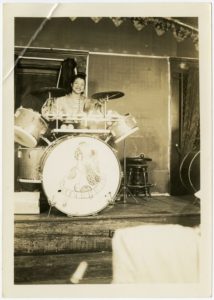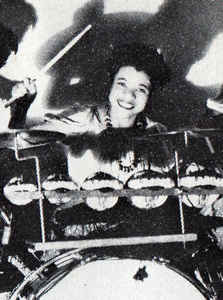Pauline Braddy (February 14, 1922 – January 28, 1996)
One of the first African-American female drummers was Pauline Braddy, who was both successful and internationally famous in the 1940s. She was a jazz drummer, but some of her early chops can be heard reverberating through 1960s and 70s rock and roll. While there is a lot of talk about the influence of male jazz musicians in drum (and rock) history, Tom Tom would like to take a moment to honor the life of pioneer Pauline Braddy. Like many who rose to fill positions left empty by men at war during the 1940s, seats in Big Bands were no different; women in music emerged to the front.

Hers is an interesting story, which begins as a student at the Piney Woods School in Mississippi. Founded by Laurence C. Jones, it was an independent boarding school whose mission was to help poor and African-American children receive a good education for free in a segregated South. The school formed a band, from which grew the first integrated all-female band in history, the International Sweethearts of Rhythm. Braddy noted, “They said I had a good sense of rhythm. They said ‘Pauline is a natural.’ I cried. Who wants to play the drums?” It turns out, she did want to play the drums, and she was absolutely a natural. The International Sweethearts of Rhythm placed third in a band competition in 1940, the only all-girl band to compete out of thirty contestants. Still, Braddy encountered prejudice, and lamented that others would often say, “Oh no, not a girl!” Many expected her to quit music and learn how to “cook and all that kind of stuff,” or move into a more socially acceptable and stereotypical role of femininity. She left the Sweethearts when she was 33, moving on to play and tour with numerous other jazz ensembles and musicians through the 1960s, until hanging up her sticks to take care of her ailing mother.
But lest we forget, the band was called “one of the hottest stage shows to ever hit the roof” after their show at the Chicago Regal Theater in 1943. Similar reviews were printed all over the nation and abroad, especially after touring Europe with the USO. Braddy became known as “Queen of the Drums” and garnered applause for her instrumentation. She was even considered the highlight during each performance with the Sweethearts. While much is known about her contemporary, legend Viola Smith (who, at 106, is one of the oldest living drummers and a pioneer in her own right), Braddy was also well-known in her day and was viewed as rival to Gene Krupa. Her admirers were some of the best and most well-known in the business, like acclaimed drummers Big Sid Catlett and Papa Jo Jones. During her trademark song, “Drum Fantasy,” Braddy was wont to dip her sticks in fluorescent paint; during live shows, and with the aid of black light and gloves, she could create a colorful spectacle, anticipating the stage tricks of 1960s psychedelia. She passed away in 1996 but will be remembered as a queen.
Listen to incredible audio of Braddy soloing and pounding the skins.
Further Reading:
Chicago Defender in Daniels, D.H. (2006) One O’clock Jump: The Unforgettable History Of The Oklahoma City Blue Devils. Beacon Press. p. 197.
Angela Smith, Women Drummers: A History from Rock and Jazz to Blues and Country, 2015, pp. 34-5.
Sally Placksin, American Women in Jazz: 1900 to the Present, 1982, p. 136.


